Complete Solutions to Exercise of chapter SOLID STATE of Class 12 book with complete answers and questions
| Class 12 | CHEMISTRY |
| Chapter | SOLID STATE |
| P BAHADUR | Exercise |
| Number Of Questions | 100 |
| Academic Year | 2023-24 |
The first `-` order diffraction os `X-` rays from a certain set of crystal planes occurs an angle of `11.8^(@)` from the planes. If the planes are `0.281 nm` apart, what is the wavelength of `X-` rays?
View SolutionUnder what conditions, the Bragg's equation wl fail to define a crystal ?
View SolutionCalculate the number `(n)` of atoms contained within `(a)` cubic cell, `(b)` a body `-` centred cubic cell, `(c)` a face `-` centred cubic cell.
View SolutionAt room temperature, sodium crystallized in a body`-`centred cubic lattrice with `a=4.24Å`. Calculate theoretical density of sodium `(` at wt. of`Na =23)`.
View SolutionSilver crystallizes in fcc lattic. If the edge length of the cell is `4.07 xx 10^(-8) cm` and density is `10.5 g cm^(-3)`. Calculate the atomic mass of silver.
View SolutionCopper crystallizer into an fcc lattice with edge length `3.61 xx 10^(8) cm`, Show that the calculated density in in agreement with its measured value of `8.92 g cm^(3)`.
View SolutionFormula mass of `NaCl` is `58.45g mol^(-1)` and density of its pure form is `2.167g cm^(-3)`. The average distance between adjacent sodium and chloride ions in the crystal is `2.814xx10^(-8)cm`. Calculate Avogadro constant.
View SolutionThallium chloridde, `TlCl` crystallized in either a simple cubic lattice or a face `-` centred cubic lattice of `Cl^(c-)` ions with `Tl^(+)` ions in the holes. If the density of the solid is with `Tl^(+)` ions in the holes. If the density of the solide is `9.00g cm^(-3)` and edge of the unit cell is `3.85xx10^(-8) cm`, what is the unit cell geometry ?
View SolutionSodium metal crystallises in body centred cubic lattic with cell edge `4.29 Å` .What is the radius of sodium atom ?
View SolutionNiobium crystallizes in body-centred cubic structure. If the density is `8.55 g cm^(-3)`, calculate the atomic radius of niobium using its atomic mass `93 u`.
View SolutionAluminium crystallizes in a cubic close-packed structre. Its metallic radius is `125 ppm`
a. What is the length of the side of the unit cell?
b. How many unit cell are there in `1.00 cm^(3)` of aluminium?
View SolutionGold (atoic radius = 0.144 nm) crystallizes in a facelcentred unit cell. What is the length of a side of the cell?
View SolutionA solid `AB` has `NaCl` structure. If the radius of the cation `A` is `100` pm, what is the radius of anion `B`?
View SolutionThe radius of `Cs^(+)` ion is `160pm` while the radius of `Cl^(-)` ion is `181pm`. Suggest the co`-`ordination of cesium in `CsCl`.
View SolutionIf the radius of the octaheral void is `r` and the radius of the atoms in close-packing is `R`, derive relation between `r` and `R`
View SolutionAnalysis shows that nickel oxide has the formula `Ni_(0.98)O_(1.00)`. What fractions of nickel "exist" as `Ni^(2+)` and `Ni^(3+)` ions?
View SolutionA compound formed by elements `A` and `B` crystallizes in cubic structure, where `A` atoms are at the corners of a cube and `B` atoms are at the face `-` centre. What is the formula of the compound ?
View SolutionThe figure below show the locations of atoms in three crystallographic planes in an fcc lattice. Draw the unit cells for these structure and identify these planes in your diagrams.
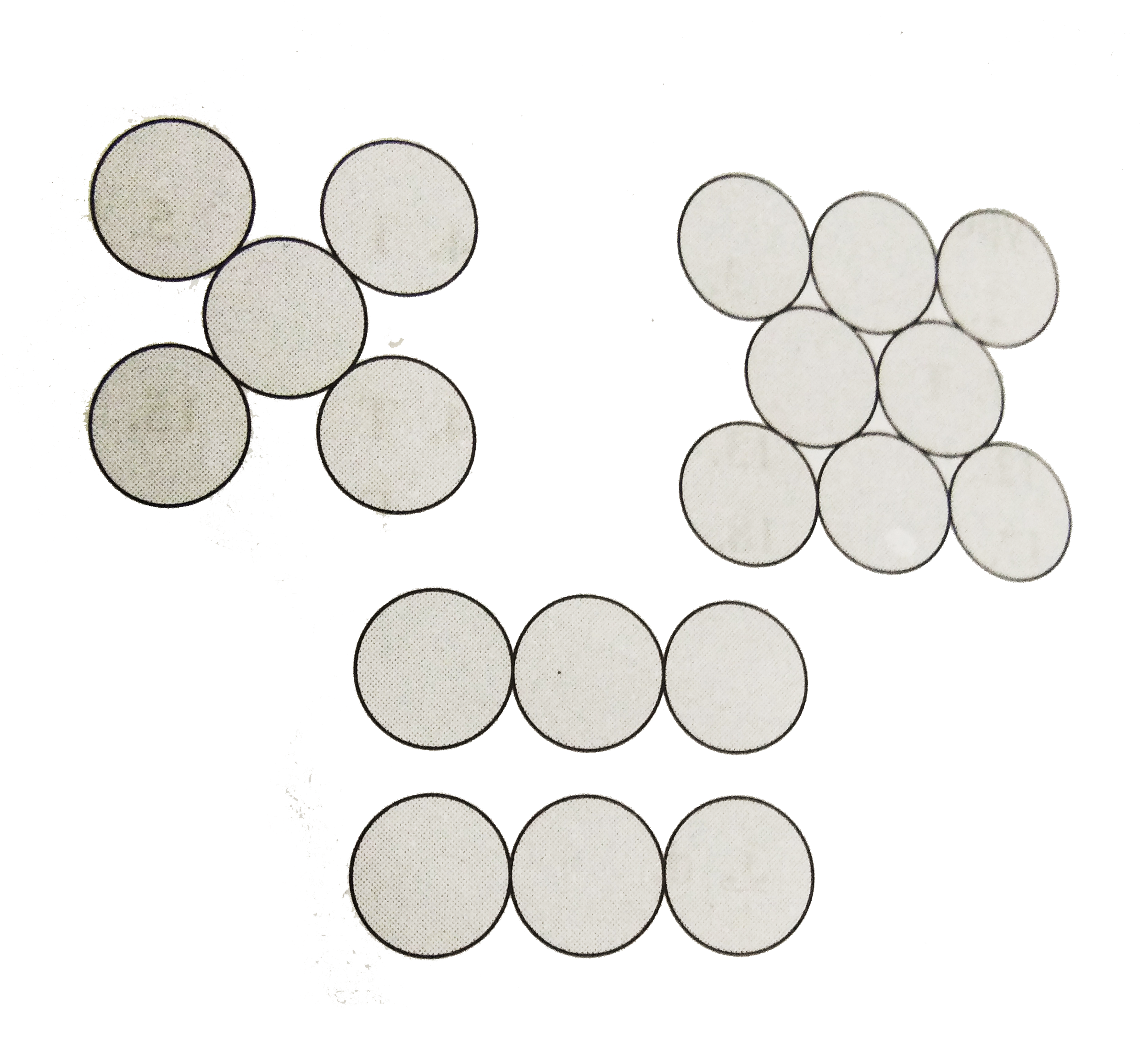
View SolutionSodium metal crystallises in body centred cubic lattic with cell edge `4.29 Å` .What is the radius of sodium atom ?
View SolutionChromium metal crystallizes with a body-centred cubic lattice. The length of the unit cell edge is found to be `287`pm. Calculate the atomic radius. What woulds be the density of chromium in `g cm^(-3)`?
View SolutionA metal crystallizes into two cubic phases, face-centred cubic and body-centred cubic, which have unit cell lengths `3.5` and `3.0 A`, respectively. Calculate the ration of densities of fcc and bcc.
View SolutionA unit of cell of sodium chloride has four formula units. The edge length of the unit cell is `0.564 nm`. What is the density of sodium chloride?
View SolutionYou are given marbles of diameter `10mm`. They are to be placed such that their centres are laying in a square bound by four lines each of length `40mm`. What will be the arrangements of marbles in a plane so that maximum number of marbles can be placed inside the area? Sketch the diagram and derive expression for the number of molecules per unit area.
View SolutionA compount `AB` has a rock type structure with `A:B=1:1`. The formula weight of `AB` is `6.023 Y am u` and the closed `A-B` distance is `Y^(1//3) nm.`
`(i)` Find the density of lattice.
`(ii)` If the density of lattice is found to be `20 kg m^(-3)`, then predict the type of defect.
View SolutionAn element crystallises in `f.c.c.` lattice having edge length `400 p m`. Calculate the maximum diameter, which can be placed in interstitial sites without disturbing the structure.
View SolutionThe edge length of unit cell of a metal having molecular weight `75 g mol^(-1)` is `5 Å` which crystallizes in cubic lattice. If the density is `2 g cc^(-1)`, then find the radius of metal atom `(N_(A) = 6 xx 10^(23))`. Give the answer in pm.
View SolutionUnit cell of `Fe_(2)O_(4)(` Ferrous ferrite `)` has `32O^(2-)` ions in the unit cell. Then the unit cell of `Fe_(3)O_(4)` has `:`
View SolutionParamagnetic substances are those, in which the individual atoms, ions or molecules posses a permanent magnetic dipole moment. In the absence of an external magnetic field, the atomic dipoles of paramagentic substance are as below`:`
View SolutionIn the above question, if an external magnetic field is applied, then the answer is `:`
View SolutionWhich of the following gases are of paramagnetic nature ?
View SolutionWhich of the following materials is not ferromagnetic ?
View SolutionFor the structure of solid given below, if the lattice points represent `A^(+)` ions and the `B^(-)` ioins occupy the tetrahedral voids, then coordination number of `A` is `:`
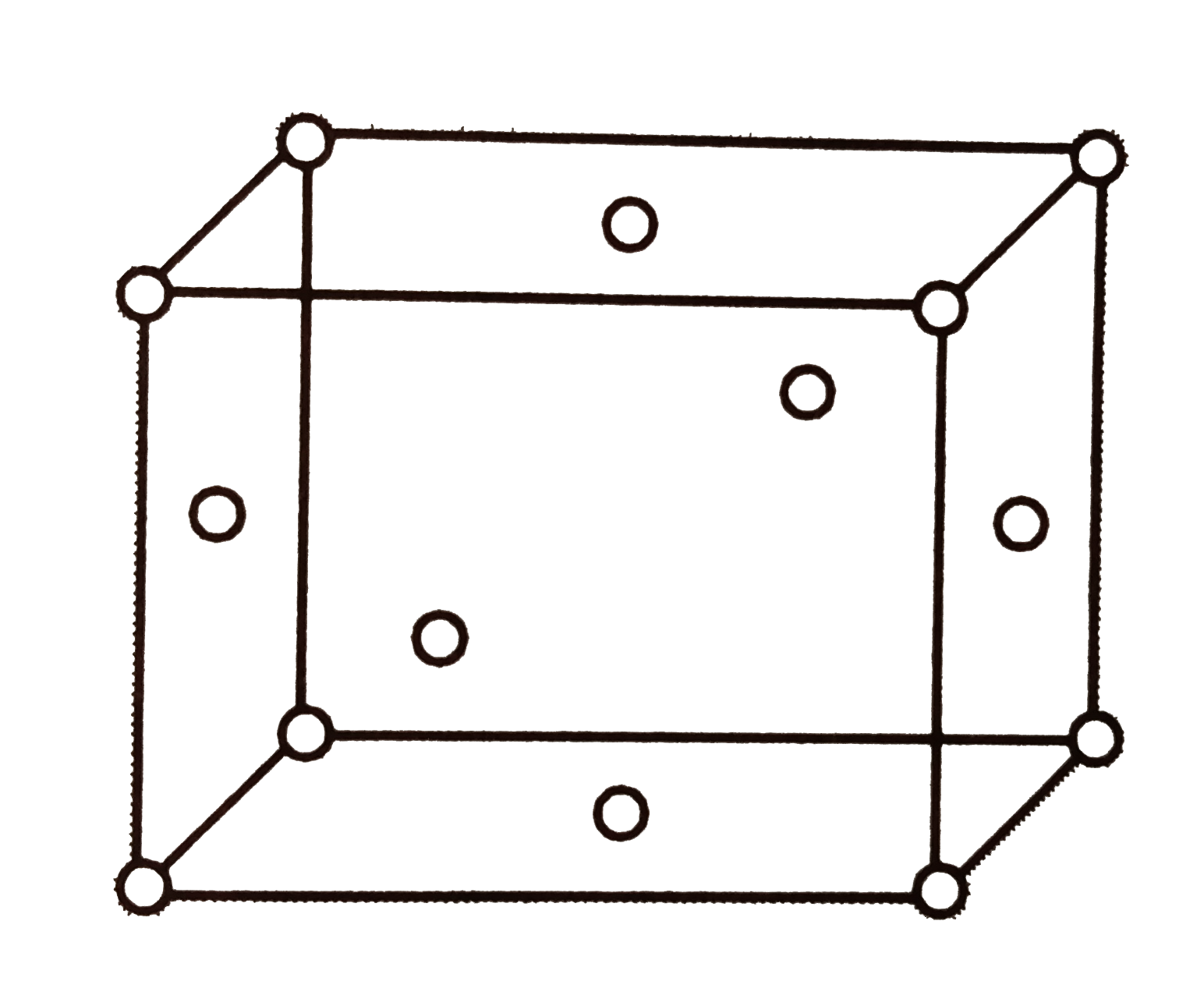
View SolutionIn a crystal, some ions are missing from normal sites. This is an example of `:`
View Solution`TiO_(2)` is well known example of `:`
View SolutionFor a solid with the following structure, the coordination number of the point `B` is `:`
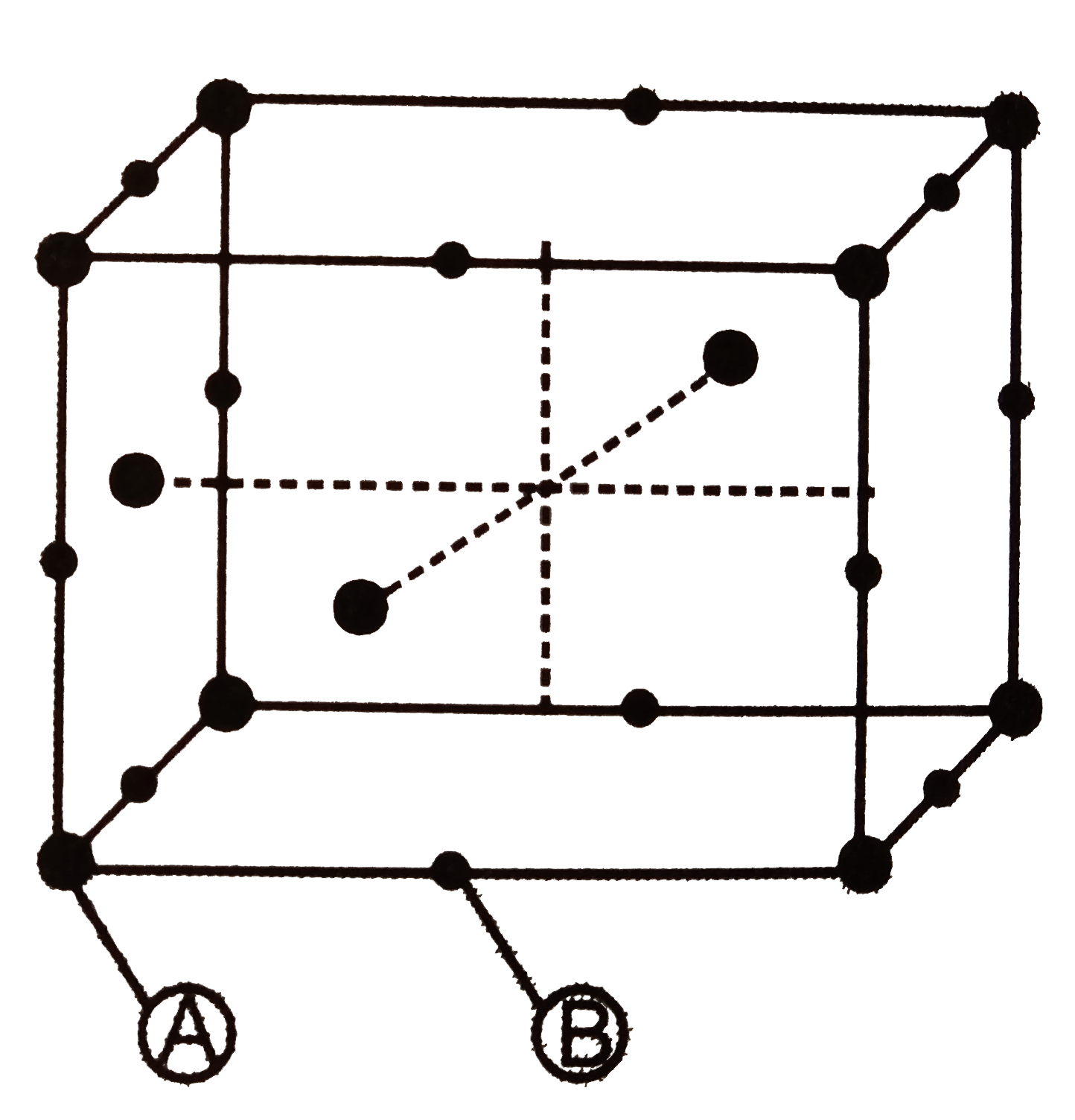
View SolutionFor the structure given below, the site marked as `S` is a `:`
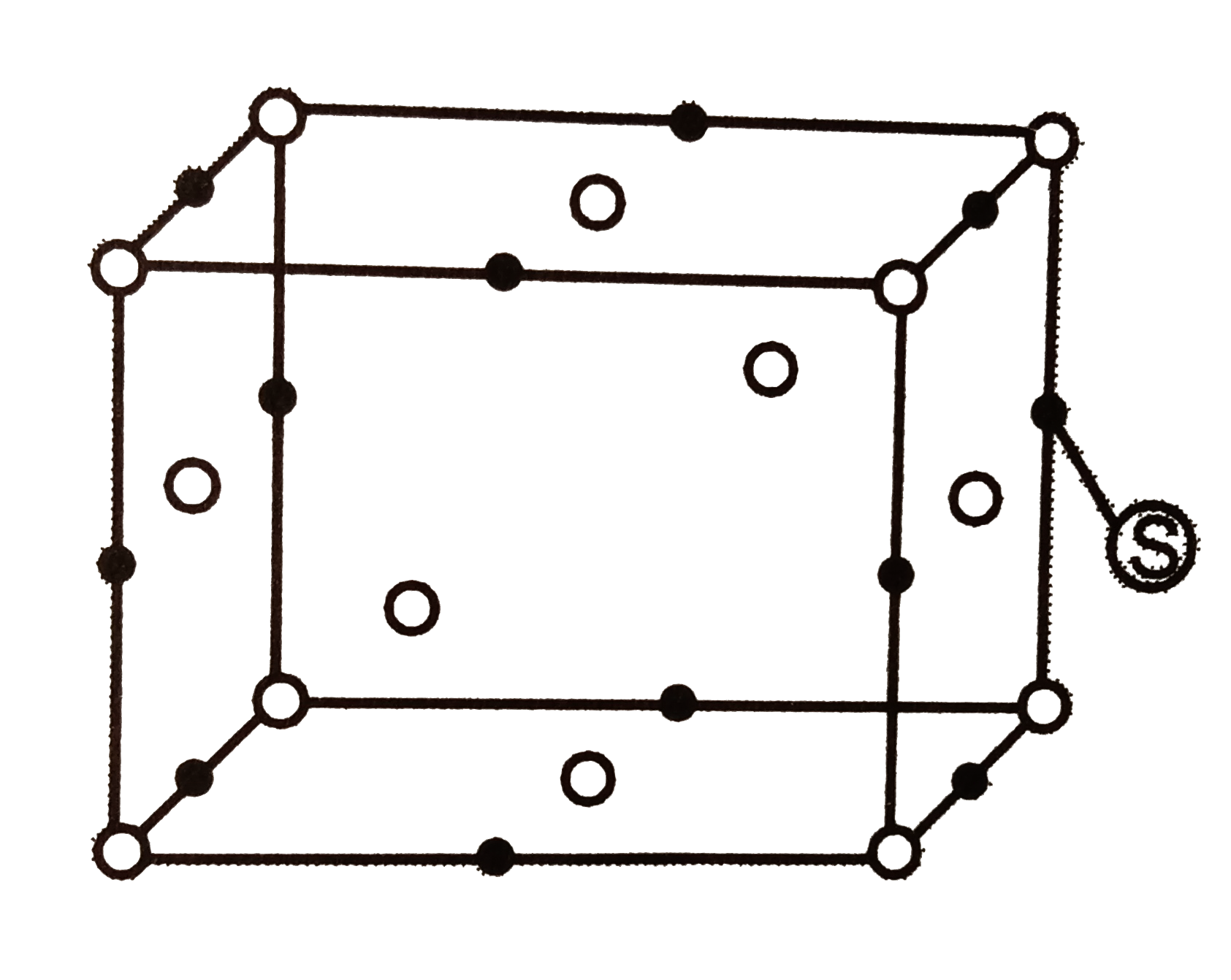
View SolutionThe structue of sodium chloride crystal is `:`
View SolutionMost crystals show good cleavage because their atoms, ions and molecules are `:`
View SolutionThe following structure drawn is of`:`

View SolutionThe co`-`ordination number of a body `-` centred atom is `:`
View SolutionThe ratio of closed packed atoms to tetrahedral holes in cubic close packing is `:`
View SolutionThe vacant space in body `-` centred cubic lattice `b.c.c.` unit cell is about`,`
View SolutionThe melting point of `RbBr` is `682^(@)C`, while that of `NaF` is `988^(@)C` . The principla reason that melting point of `NaF` is much higher than that of `RbBr` is that `:`
View SolutionIn solid `NH_(3)` each `NH_(3)` molecule has six other `NH_(3)` molecules as nearest neighbouts. `DeltaH` of sublimation of `NH_(3)` at the melting point is `30.8 kJ mol^(-1)` and the estimated `DeltaH` of sublimation in the absence of `H-` bonding is `14.4kJ mol^(-1)`. What is the strength of a hydrogen bond in solid ammonia ?
View SolutionExtremely pure samples of `Ge` and `Si` are non`-`conductors, but their conductivity increases suddenly on introducting `…………………….` in their crystal lattice
View SolutionThe crystals are bonded by plane faces `(f)` straight edges `(e)` and interfacial angle `(c)`. The relationship between these is `:`
View SolutionAn alloy of `Cu, Ag` and `Au` is found to have copper constituting the `c.c.p.` lattice. If `Ag` atom occupy the edge centres and `Au` atom is present at body centre, the formula of this alloy is `:`
View SolutionThe ratio of cations to anion in a octahedral close packing is `:`
View SolutionIf `a` is the length of unit cell, then which one is correct relationship ?
View SolutionThe unit cell with the structure below refers to `…………………….` crystal system.

View SolutionIn the cubic lattice given below, the three distances between the atoms `A-B, A-C`, and `A-G` are, respectively,
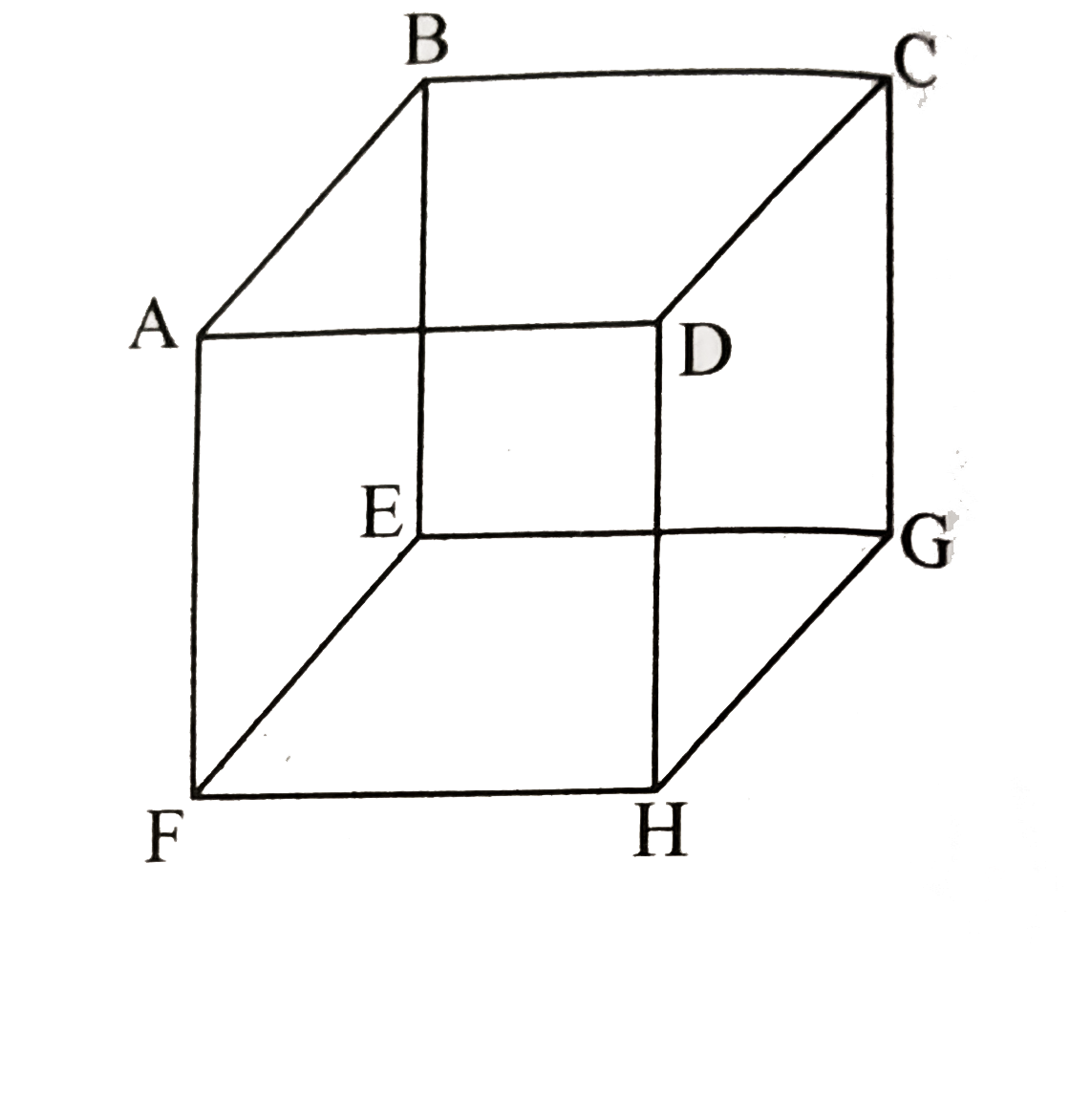
View SolutionA solide `A^(+)B^(-)` has the `B^(-)` ions arranged as below. If the `A^(+)` ions occupy half of the tetrahedral sites in the structure. The formula of solid is `:`

View SolutionThe radius of the `Na^(2+)` is `95p m` and that of `Cl^(-)` ion is `181 p m`. Predict the co`-` ordination number of `Na^(+) :`
View SolutionA metal crystallises in `b.c.c.` lattice. The per cent fraction of edge length not covered by atom is `:`
View SolutionSilicon doped with arsenic is an example of `:`
View SolutionWhich of the following statements is not correct?
View SolutionIn a `f.c.c.` arrangement of `A` and `B` atoms, where `A` atoms are at the corners of the unit cell and `B` atoms at the face `-` centres, one of the `A` atom is missing from one corner in each unit cell. The formula of compound is `:`
View SolutionHow many tetrahedral holes are occupied in diamond ?
View SolutionA solid `XY` has `NaCl` structure. If radius of `X^(+)` is `100 p m`. What is the radius of `Y^(-)` ion ?
View SolutionThe density of `KBr` is `2.75 g cm^(-3)` length of the unit cell is `654 p m` . `K=39, Br=80, `then what is true about the predicted nature of the solide ?
View SolutionIn the fcc arrangement of `A` and `B` atoms whose `A` atoms are at corners of the unit cell and `B` are at the face centres one of the `A` atom is missing from one corner in each unit cell. What is the simplest formula of the compound?
View SolutionThe number of atoms per unit cell in a simple cube, face `-` centred cube and body`-` centred cube are respectively `:`
View SolutionAntifluorite structure is for `:`
View SolutionTwo ionic solid `AB` and `CB` crystallise in the same lattice. If `r_(A^(+))//r_(B^(-))` and `r_(C^(+))//r_(B^(-))` are `0.50` and `0.70` respectively, then the ratio of edge length of `AB` and `CB` is `:`
View SolutionA matchbox exhibits `:`
View SolutionWhich arrangement of electrons leads to ferromagnetism ?
View SolutionFerrimagnetic is converted into ferromagnetic at `:`
View SolutionAn alloy of copper and gold crystallizes in cubic lattic, in which the `Au-` atoms occupy the lattice points at the corners of cube and `Cu-` atoms occupy the centre of each face. The formula of this alloy is `:`
View SolutionThe crystal structure adopted by iron is shown below. The distance between the nearest iron atoms is `:`
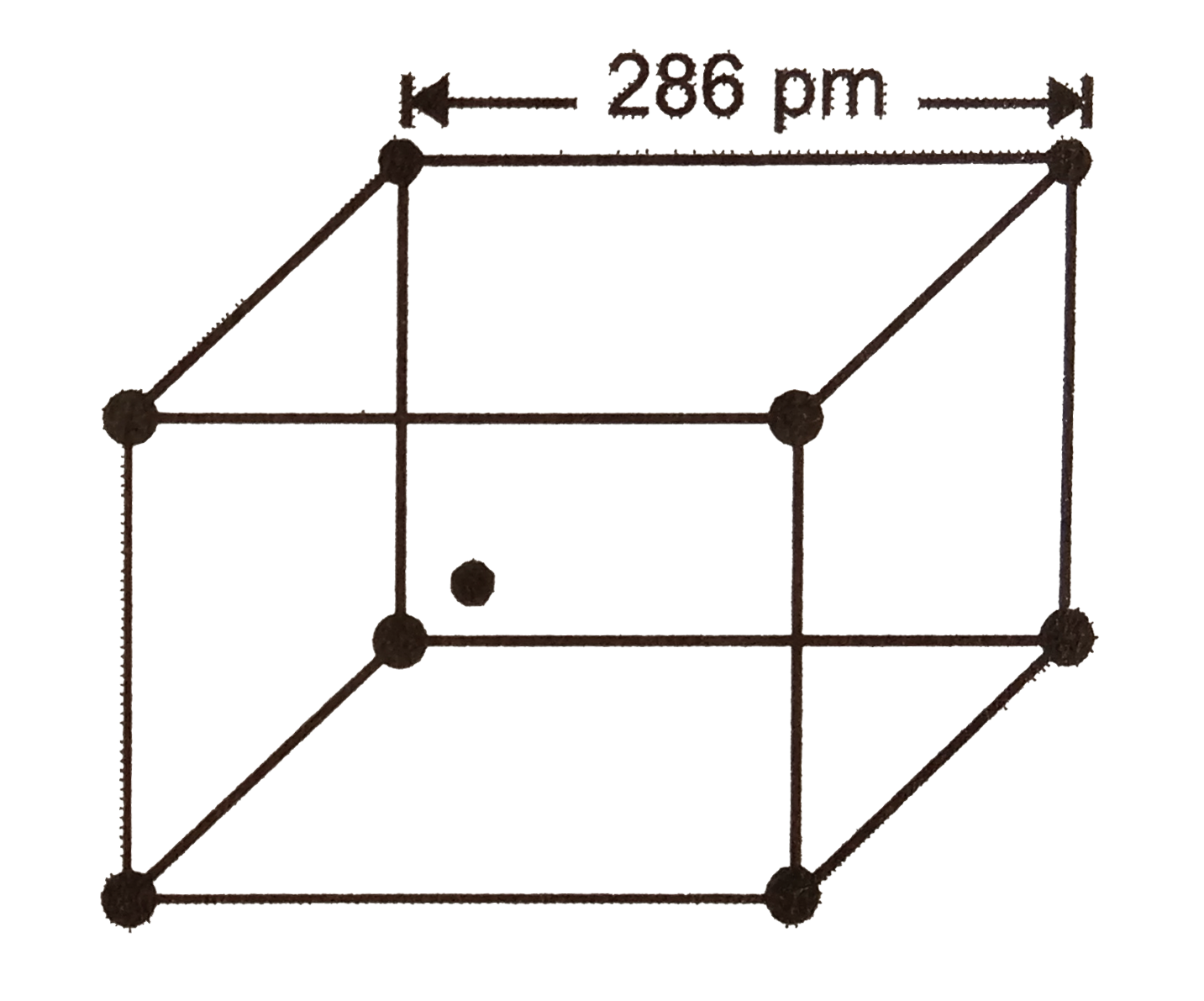
View SolutionWhich of the following figures represents the cross section of an `OV`?
View SolutionThe `Ca^(2+)` and `F^(-)` ions located in `CaF_(2)` crystal respectively at `f.c.c.` lattice points and in`:`
View SolutionIf `r` is the radius of the octahedral voids and `R` is the radius of the atom in close packing,then `:`
View SolutionCsBr crystallises in a body centred cubic lattice. The unit cell length is 436 pm. Given that the atomic mass of Cs = 133 and that of Br = 80 amu and Avagadro number being `6.02xx10^(23)mol^(-1)` the density of CsBr is
View SolutionThe appearance of colour in solide state of alkali metal halides is generally due to `:`
View SolutionThe mole fraction of Schottky defect and Frenkel defects, in `NaCl` crystal at `1000K` are respectively. If energy required to produce these defects are `2eV` and `3eV` respectively.
`(1eV=1.6xx10^(-19)J` and `k=1.38xx10^(-23)JK^(-1))`
View SolutionIf `a ` stands for the edge length of the cubic system `:` simple cubic, body `-` centred cubic anf face `-` centred cubic, then the ratio of radii of the spheres in these systems will be respectively`:`
View SolutionWhich of the following relation is correct for first order Bragg's diffraction?
View Solution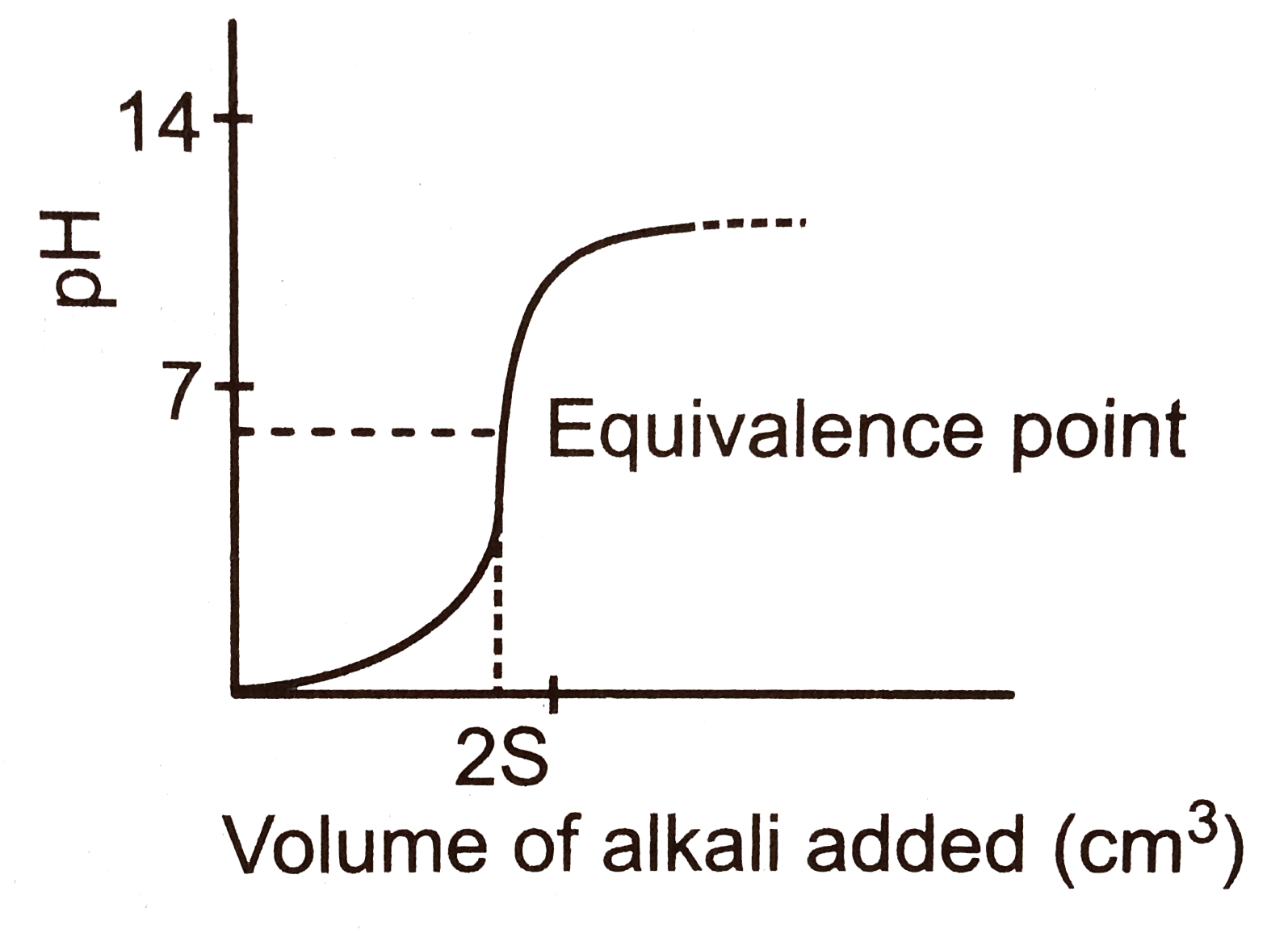
The graph represents the titration curve for `:`
View SolutionWhich of the following statements are correct ?
View SolutionThe corrent statement regarding defects is solids in solids is
View SolutionWhich of the following are not the characteristics of crystalline solids ?
View SolutionWhich of the following statements are correct ?
View SolutionWhich of the following statements are false ?
View SolutionIf the radius of `Na^(+)` ion is `95 p m` and that of `Cl^(-)` ion is `181 p m`, then `:`
View SolutionWhich of the following having their radius ratio between `0.414` to `0.73,i.e.,` for `NaCl` structure have their radius ration not in theis range but possess `NaCl` type structure ?
View SolutionWhich of the following statement `(s)` is `(` are`)` correct ?
View SolutionIn the crystal structure of `CsCl:`
View SolutionIf radius of anion is `0.20nm`, the maximum radius of cations which can be filled in respective voids are correctly matched in `:`
View SolutionWhich of the following statement`(s)` is `(are)` correct for `CaF+(2)`?
View SolutionWhich of the following statement are correct for the ionic solids in which positive and negative ions are held by strong electrostatic attractive forces ?
View Solution`Na` and `Mg` crystallise in `b.c.c.` and `f.c.c.` type crystals respectively, then the number of atoms of `Na` and `Mg` present in the unit cell of their repsectively crystal is `:`
View SolutionHow many unit cell are present in a cubic-shaped ideal crystal of `NaCl` of mass `1.0 g`?
View SolutionWhat type of crystal defect is indicated in the diagram given below
`{:(Na^(o+),Cl^(ɵ),Na^(o+),Cl^(ɵ),Na^(o+),Cl^(ɵ)),(Cl^(ɵ),square,Cl^(ɵ),Na^(o+), square, Cl^(ɵ)),(Na^(o+),Cl^(ɵ),square,Cl^(ɵ),Na^(o+),Cl^(ɵ)),(Cl^(ɵ),Na^(o+),Cl^(ɵ),Na^(o+),square,Na^(o+)):}`
View SolutionAn ionic compound has a unit cell consisting of A ions at the corners of a cube and B ions on the centers of the faces of the cube .The empirical formula for this compound would be
View SolutionThe volume of atom present in a face-centred cubic unit cell of a metal (`r` is atomic radius ) is
View SolutionIn a compound atoms of element `Y` form ccp lattice and those of element `X` occupy `2//3^(rd)` of tetrahedral voids .The formula of the compound will be
View SolutionCopper crystallises in fcc with a cell length of 361 pm .What is the radius of copper atoms?
View SolutionThe edge length of a face-centred cubic unit cell is `508 pm`. If the radius of the cation is `110 pm` the radius of the anion is
View SolutionPercentage of free space in cubic close packed struchure and in body centred structure are respectively.
View SolutionIn a face centred cubic lattice, atom `A` occupies the corner positions and atom `B` occupies the face centred positions. If one atom of `B` is missin from one of the face centred points,, the formula of the compound is `:`
View Solution
Exercise questions and complete solutions for chapter SOLID STATE of P BAHADUR CHEMISTRY (HINGLISH) of Class 12